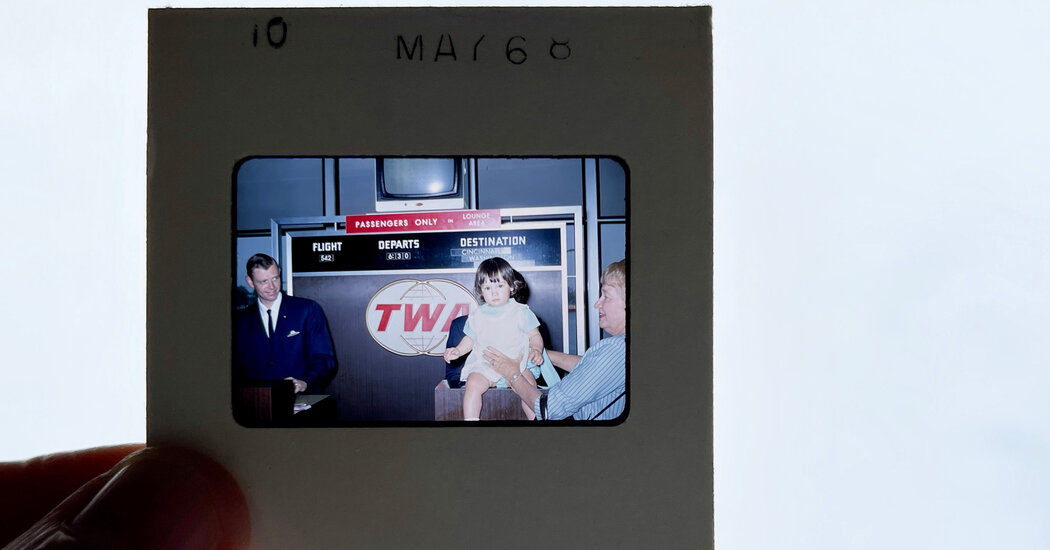Photography started going digital about 30 years ago, so if you’re older, your relatives probably documented some of your childhood on film-based formats, such as slides or prints made from negatives. Or maybe you have piles of your old slides and negatives of long-lost photos in the attic or garage. While not as simple as scanning old photo prints, digitizing that film saves the family history from outdated media and makes it easy to share the recovered memories. Here are a few ways to get the job done.
The smartphone method
As with printing, you can “scan” a slide or negative with your smartphone by taking a photo of it or using one of the many slide/movie scanning apps. For best results, make sure the original is free of dust and evenly illuminate the transparencies from behind. An inexpensive scan kit — which provides both the backlight and a place to rest your phone for a more stable shot — is an option.
Kodak’s Mobile Film Scanner kit ($40 or less) is an option. It works with the free Kodak Mobile Scanner app for Android or iOS. Simply place a slide or negative on the battery-powered LED backlight, then aim the phone’s camera at it from above and take a photo. Depending on your phone and camera(s), you may need to experiment with distance and focus to get sharp photos.
Rybozen makes a similar film scanner for smartphones. You can also make your own slide scanner from commonly used materials to take pictures with your smartphone or stand-alone camera with a macro lens for close-up focus. YouTube hosts several videos on the subject – just search for “DIY film scanner” or similar wording to find several tutorials from DIY enthusiasts.
Photomyne’s inventive SlideScan app ($40 for two years; a free trial is available) is another option. You hold the slide in front of a laptop with a plain white webpage on it and take a picture of it; the software enhances and crops the resulting image automatically, or you can make manual adjustments. Photomyne’s separate FilmBox app does the same for negatives. FilmLab ($6 per month) is another smartphone scanning app with Windows and Mac versions.
Smartphone scanning has some drawbacks. You won’t get the best results and it can be annoying if you have a lot of images. But it is relatively cheap.
The scanner method
Smartphones can be all-purpose devices, but using hardware designed for a specific task often produces better results. If you need to convert boxes of transparencies, investing in a compact film scanner (such as those from Wolverine or Kodak) can simplify and speed up the process for about $150; Plustek makes more expensive models.
A flatbed scanner that can handle film as well as prints and documents is another option, such as the Epson Perfection V600 (about $250 online). Wirecutter, The New York Times’ product review site, also has scanner recommendations.
If you already have a flatbed scanner for documents and photos, check your model’s manual to see if it can handle slides and film negatives, as some have that capability. If your scanner is not equipped to handle transparencies, you can make your own silver card stock adapter to diffuse the light from the scanner and illuminate the image; Make:magazine has a free template and instructions online, just like other DIY sites.
And be sure to scan the images at a high enough resolution to look good enlarged and for printing; 3,200 pixels per inch is common.
The professional method
If you don’t have the time, patience, or equipment, sending photos to a media conversion company like Memories Renewed, ScanMyPhotos, or DigMyPics is another option. Most shops charge per slide – prices can start around 21 cents each.
For your money you get high quality images. Some companies allow you to preview the results and even skip a certain number of duds in your collection. Your originals will be returned after scanning is complete and your digital copies are ready.
Get ‘Gram-worthy’
Slides and negatives can fade over time, especially if not properly stored. Many smartphone film scanning apps also include basic editing tools to adjust colors and crop. And you can always use Apple Photos and Google Photos for mobile and desktop for quick, free photo editing to get those photos ready to share.
Share and save space
All the time, effort and (possibly) money that you put into digitizing the old film provides another advantage in addition to the easy-to-share photo files. You can store them in a safe place online as a backup – and as the new archive if you decide to part with the originals during spring cleaning.

